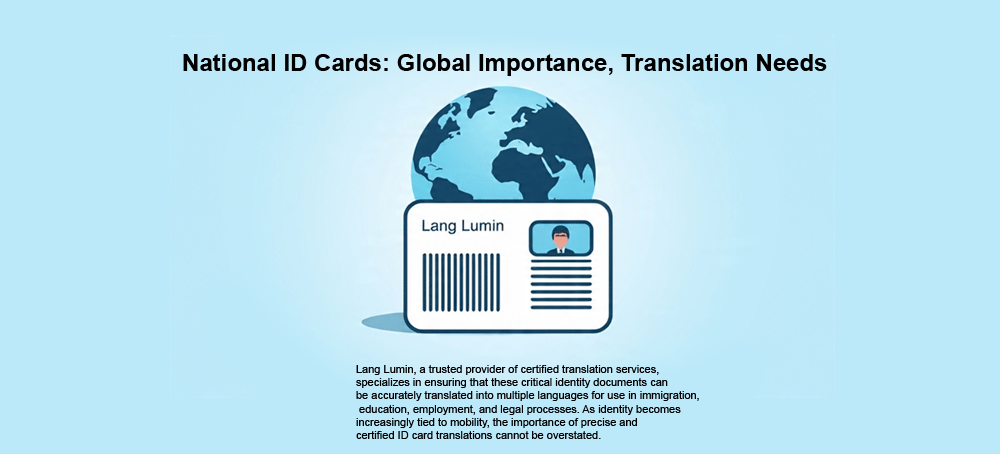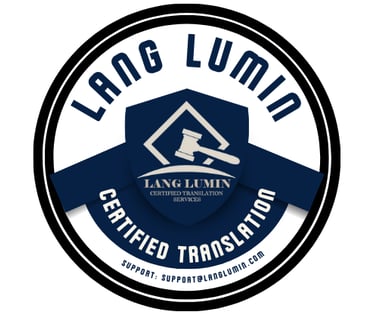instant chat support: +923411211315

National ID Cards: Global Importance, Translation Needs, and How Lang Lumin Helps
Lang Lumin, a trusted provider of certified translation services, specializes in ensuring that these critical identity documents can be accurately translated into multiple languages for use in immigration, education, employment, and legal processes. As identity becomes increasingly tied to mobility, the importance of precise and certified ID card translations cannot be overstated.
Lang Lumin


Introduction to National ID Cards
A national identity card, often referred to as a national ID card, is a government-issued document that establishes a citizen’s legal identity within a state. It generally contains critical personal details such as a person’s full name, date of birth, gender, photograph, national identification number, and increasingly biometric information such as fingerprints, iris scans, and facial recognition patterns. National ID cards have become indispensable tools of governance and citizenship in almost every part of the world. They function as a gateway to public services, voting rights, social security, banking systems, healthcare access, and international travel. In today’s globalized society, national ID cards not only identify individuals within their own country but also act as key legal documents when citizens move across borders.
History and Evolution of Identity Documents
The idea of carrying proof of identity is not new. In ancient Egypt, officials recorded population details on papyrus scrolls, and Roman citizens often carried documents verifying their status. In medieval Europe, travelers were issued passes that allowed them to move between towns. By the nineteenth and early twentieth centuries, passports and residency permits began to formalize as standardized identity proofs, often tied to nation-states and international agreements.
After World War II, many governments introduced permanent national ID cards as a means of population management, national security, and administrative control. In the twenty-first century, identity systems have shifted dramatically toward digital and biometric technologies. Countries such as Estonia pioneered the e-ID, an entirely digital identity system that integrates with banking, voting, and healthcare. India launched Aadhaar, the world’s largest biometric identification project, linking over a billion citizens to a single identity number. Pakistan, through NADRA, created one of the most sophisticated computerized national identity card (CNIC) systems, incorporating biometrics and chips. These developments highlight a trend toward making identity documents simultaneously more secure, accessible, and digital.
Types of National ID Cards
National identity systems differ by country, but they generally fall into categories based on technology. Traditional physical ID cards remain common worldwide, produced in laminated paper or plastic. However, digital identity cards are rapidly becoming mainstream. A digital ID allows citizens to use mobile apps or online portals for verification instead of carrying a physical card. Estonia’s e-residency program is a prime example, enabling foreigners to establish a digital identity recognized globally.
Smart cards represent another evolution. These cards carry embedded microchips that store encrypted data such as biometric fingerprints, banking credentials, and health records. Biometric ID cards are now widespread, requiring citizens to register with fingerprint scans, iris recognition, or facial mapping to ensure uniqueness and prevent fraud. Countries like Pakistan, Nigeria, and the United Arab Emirates have adopted these systems.
For translation purposes, the type of card matters greatly. Translating a paper card involves replicating text details such as names and numbers, whereas translating biometric-enabled smart cards requires both technical accuracy and legal certification to ensure the data is properly recognized across international borders. Lang Lumin’s translators are trained to handle both traditional and modern ID card formats with precision.
Global Overview of National ID Systems
National identity cards differ widely across continents. In Asia, Pakistan’s CNIC is mandatory for accessing nearly every public service, while India’s Aadhaar number links citizens to taxation, welfare, and even mobile phone subscriptions. China issues a Resident Identity Card that includes a digital chip used for travel, work, and healthcare.
In Europe, most countries require a national ID card. Germany’s Personalausweis includes electronic verification features, Spain’s DNI electrónico has a built-in digital signature system, and Estonia has pioneered digital residency with global recognition.
African countries have also embraced modern ID systems. Nigeria’s National Identity Number is tied to banking, mobile communications, and voting, while South Africa’s smart ID card incorporates biometric security.
In the Middle East, the Emirates ID in the United Arab Emirates is not only a proof of identity but also integrates banking, healthcare, and government services. Saudi Arabia requires every citizen and resident to hold a national ID card for legal recognition.
The Americas present a mixed case. The United States does not have a centralized national ID card but relies on Social Security Numbers, state-issued driver’s licenses, and the Real ID Act. Canada uses provincial ID cards and passports for verification. Brazil recently introduced new digital ID systems to modernize identification.
This diversity underscores why translation services are critical. A Pakistani citizen applying for Canadian immigration must translate their CNIC into English, while a Spanish national enrolling in a US university must provide a certified translation of their DNI. Lang Lumin bridges these gaps, ensuring compliance with international requirements.
Legal Importance of National ID Cards
National ID cards are often the foundation of a person’s legal identity. They determine voting rights, enable property ownership, allow access to healthcare and social benefits, and are mandatory for financial transactions such as opening a bank account. Without proper identity documents, individuals cannot legally marry, register births or deaths, or apply for visas.
When these documents need to be used abroad, accurate translations become mandatory. Immigration offices, universities, and courts often reject documents that are not translated by certified professionals. An incorrectly translated ID card can lead to visa denial, application delays, or even accusations of fraud. Lang Lumin ensures that translations are accurate, legally valid, and recognized internationally, thereby protecting clients from unnecessary risks.
National ID Cards and Immigration
Immigration is one of the most common scenarios where national ID cards require translation. When applying for visas, residency permits, or citizenship, embassies request certified copies of national identity cards in the official language of the destination country. For example, a Pakistani CNIC must be translated into English for Canadian or American applications, while a French national ID must be translated into German for use in Germany.
Lang Lumin specializes in providing translations that meet the strict requirements of immigration authorities. Every translation includes certification and, when necessary, notarization to confirm its authenticity. Clients rely on these translations for work permits, student visas, and permanent residency applications.
Challenges of Multilingual National IDs
National ID cards pose unique challenges for translation. Many cards use non-Latin scripts such as Arabic, Chinese, Cyrillic, or Urdu, which require transliteration into Latin characters. Transliteration can result in multiple variations of a single name, creating inconsistencies. For instance, the Arabic name محمد could be transliterated as Mohammed, Mohamed, or Mohammad.
Date formats also vary, with some countries using the Hijri calendar while others rely on Gregorian. An incorrectly translated date could cause a visa rejection. Additionally, some ID cards contain abbreviations or codes unique to local administration, which must be accurately explained in the target language. Lang Lumin addresses these challenges with a team of expert translators who specialize in both linguistic accuracy and cultural context.
The Role of Translation in National ID Usage
Translation plays a vital role in ensuring that identity documents are legally recognized worldwide. A certified translation validates not only the language accuracy but also the authenticity of the information. Translated ID cards are accepted by embassies, universities, hospitals, banks, and legal courts. They prevent misunderstandings that could otherwise lead to denial of services or legal consequences.
Lang Lumin has built its reputation on producing translations that are accepted globally. From translating Pakistani CNICs into English for Canadian immigration to converting Spanish DNI cards into English for US legal processes, Lang Lumin ensures that clients can use their documents confidently abroad.
Lang Lumin’s Expertise in Translating National ID Cards
Lang Lumin offers certified translation services that cover over one hundred languages. The company’s translators are trained to handle sensitive identity documents with precision and confidentiality. Whether the client needs an Urdu CNIC translated into English, a Chinese Resident Identity Card translated into German, or an Arabic Emirates ID translated into French, Lang Lumin guarantees accuracy.
One of the company’s clients explained: “Lang Lumin translated my Pakistani CNIC into English for Canadian immigration. The accuracy and certification were perfect—I had zero issues at the embassy.” Such testimonials highlight the trust clients place in Lang Lumin’s services.
By providing certified, notarized, and embassy-accepted translations, Lang Lumin makes the immigration and documentation process smoother for clients worldwide.
Case Studies: Real-Life Translation Needs
Consider the case of Ali, a Pakistani student applying to study in Canada. His CNIC needed to be translated into English before submission. Lang Lumin provided a certified translation within twenty-four hours, enabling him to meet the deadline.
Maria, a Spanish citizen marrying in the United States, required her Spanish DNI card to be translated into English for legal registration. Lang Lumin handled the process seamlessly, ensuring legal recognition.
In another example, a Chinese student enrolling in a German university required a translation of his Resident Identity Card. Lang Lumin provided both translation and notarization, ensuring smooth acceptance by the university.
Frequently Asked Questions
Do I need a certified translation of my ID card for immigration?
Yes. Most embassies and immigration offices require certified translations of national ID cards. Lang Lumin provides certified translations that meet international standards.
Can Lang Lumin translate IDs written in non-Latin scripts?
Absolutely. Lang Lumin covers Arabic, Chinese, Cyrillic, Japanese, Urdu, Hindi, and many more languages.
How long does the translation process take?
Standard turnaround is between twenty-four to forty-eight hours, with same-day services available for urgent requests.
Quotations from Experts and Clients
“A mistranslated name in an ID card can cause years of delay in immigration.” — Dr. Claire Turner, Immigration Lawyer.
“Lang Lumin’s certified translations were accepted at the US Embassy without a single query.” — Maria G., satisfied client.
The Future of National ID Systems
The future of national ID systems lies in digitalization and security. Blockchain-based identity systems are being developed to provide tamper-proof verification. Mobile-based IDs are increasingly replacing physical cards, enabling people to store their identity in secure smartphone applications. Artificial intelligence is being integrated into immigration and security systems, automating the verification process.
As these developments progress, the demand for professional translation will continue. Even with digital IDs, translation remains essential because global authorities require legally recognized versions of identity documents in their official languages. Lang Lumin is well-positioned to adapt to these changes, providing high-quality translations for both traditional and digital identity documents.
How to Get Your National ID Card Translated with Lang Lumin
Getting your ID card translated with Lang Lumin is simple. You only need to scan or photograph your ID card, upload it to Lang Lumin’s secure portal, select the target language, and receive your certified translation within the promised timeframe. Lang Lumin guarantees accuracy, confidentiality, and global acceptance.
Conclusion
National ID cards are fundamental to citizenship, identity, and legal recognition worldwide. They connect individuals to healthcare, education, banking, and government services. In international contexts such as immigration and education, these cards must be translated accurately and certified for acceptance. Lang Lumin provides expert solutions, ensuring translations are precise, certified, and legally recognized across the globe.
As globalization continues to increase cross-border movement, the importance of professional translation services for national ID cards will only grow. With Lang Lumin, clients can trust that their identity documents will be translated accurately, securely, and with international recognition.
Connect
Get in touch for certified translation services.
Support
chat
Copyright © lang lumin translation 2025. All rights reserved.




